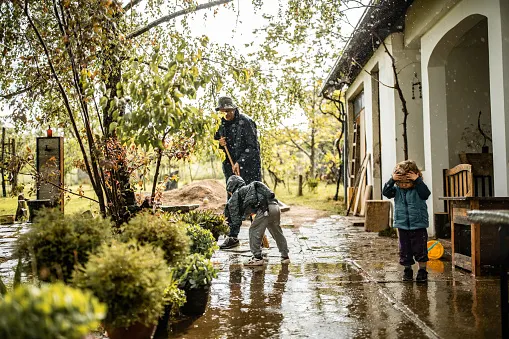
Five reasons why spring's unpredictability is just the worst
As temperatures rise and snow melts, you'll be reminded of a lot of the less welcome aspects of the season
Spring is a season of variable weather, but we probably don't have to tell you that. But it isn't only the weather that you have to watch out for as winter retreats.
So here are five things to keep in mind.
5. ARE YOU SURE YOU WANT TO REMOVE THOSE WINTER TIRES?
Winter tires tend to lose their grip when the outdoor temperature climbs above 7°C, so most auto experts recommend removing them when the day-time high consistently hovers around that mark.
But there are other factors that should go into deciding when to replace your tires with all-seasons, and most of them are location-dependent.
In Quebec, for example, it's illegal to remove winter tires before March 16, and for good reason.
Late-season snowfalls are common across Canada, especially in Quebec and along the east coast.
RELATED: Spring is here: When should you take your winter tires off?
4. PREPARE FOR FLOODS
In some parts of Canada, spring flooding is a near-annual event, due to a combination of heavy rain, warming temperatures and a melting snowpack.
If you live in a flood-prone area, there are a few things you can do to minimize the risk of property damage:
Review your home, automobile and cottage insurance policies prior to a flood. Living in a flood-prone zone may make a home ineligible for flood insurance – but living outside of a flood area doesn't necessarily ensure coverage.
"Buyers need to be aware that houses may be deemed to be a flood risk despite not being near water," Garth Macdonald, a student-at-law at Delaney’s Law Firm in Ottawa, Ont., told The Weather Network in 2015.
"Each insurance company determines which areas are at risk. Categories like 'flood plain,' 'susceptible zones,' and 'fringe flooding areas' will affect insurability, rates, and policy riders."
Inspect your home for vulnerable areas and make necessary repairs.
This includes elevating appliances that could be damaged by water, including your furnace, oil tank, water heater and electrical wiring. You may also want to install backflow valves to prevent sewer lines from backing up.
Move valuables to higher ground.
Basements are vulnerable to flooding, so it may be a good idea to remove anything of value prior to flood season.
WATCH BELOW: FLOOD-PROOF HOMES THE WAY OF THE FUTURE?
3. DON'T FORGET SUN SAFETY
It's natural to want to head outdoors when the warmer weather hits -- and when you do, be sure to wear your sunscreen.
You can get a sunburn at any time of the year and that includes cloudy days. It's important to stay safe when spending an extended period of time outdoors.
Here are a few tips:
Health experts say finding the right sunscreen is important. SPF 15 blocks 93 per cent of UVB rays, while SPF 30 blocks 97 per cent and SPF 50 blocks 98 per cent.
Remember to look for a sunscreen that offers "broad spectrum protection". This will protect against UVA rays, which can cause cancer and wrinkles.
Wear a hat, protective clothing and avoid direct sun exposure during peak times.
2. GET READY TO SNEEZE
If you're one of the estimated 25 per cent of Canadians who suffer from springtime allergies (also referred to as hay fever), we apologize.
April and May are typically the worst months for seasonal allergies, because that's when tree pollen peaks.
Fortunately, spring showers can help keep allergies (somewhat) under control.
"Not only will the rain wash out the pollen that's in the air, it's going to inhibit pollen release from the flowers that are ready to release pollen but are waiting for dry weather," biologist Estelle Levetin told the CBC in 2011.
If hay fever has a negative impact on your quality of life, talk to your doctor. There are a variety of prescription and over-the-counter remedies available.
WATCH BELOW: HOW TO FIND SEASONAL ALLERGIES IN YOUR PETS
1. TORNADOES ARE POSSIBLE
Tornado season typically doesn't peak until June or July in Canada, but tornadoes can -- and do -- happen in the spring.
Here are a few tips that can help keep you safe, courtesy of The Weather Network and the Canadian and American Red Cross.
LIGHTNING SAFETY TIPS
Stay away from windows.
Unplug appliances.
Do not use the telephone.
Avoid running tap water.
Try to reach a safe building or vehicle (picnic shelters, dugouts and sheds are NOT considered safe).
Avoid high ground, water, tall, isolated trees and metal objects such as fences or bleachers.
If you are out on the water, get to land and find shelter immediately.
IF SOMEONE IS STRUCK BY LIGHTNING
Call for help / dial 911.
The injured person has received an electrical shock and may be burned or have other injuries.
People who have been struck by lightning do not retain an electrical charge and can be handled safely.
Give first aid. If the heart has stopped beating, a trained person should give CPR.
Environment Canada offers a 30-30 rule. If you can count 30 seconds or less between seeing a lightning flash and hearing the thunder, take shelter and stay there until 30 minutes after you last hear thunder.
TORNADO SAFETY TIPS
Should a tornado develop, seek underground shelter when possible -- preferably in a basement.
In the absence of an underground room opt for a windowless interior room or hallway on the lowest level of a solid building.
Never try to outrun a tornado.
Keep cell phone and/or battery-operated radio handy so you can keep on top of tornado watches and warnings.
DO NOT go outside if a tornado is imminent or occurring in your area.
SEVERE WEATHER WARNING SIGNS
Large hail
Strong winds
Debris clouds and tree damage
Torrential rain
Severe thunder/lightning
Dark, often greenish clouds
Funnel clouds
VIDEO: HOW TO KEEP SAFE IN A TORNADO
--
Thumbnail courtesty: Getty Images/freemixer/stock photo











